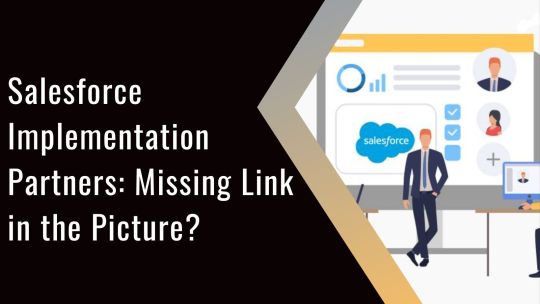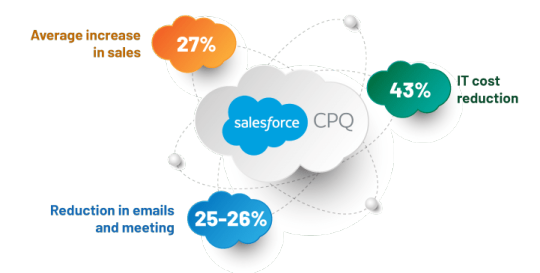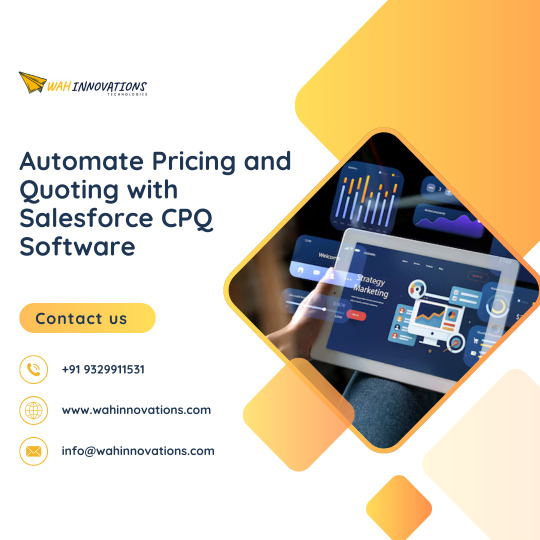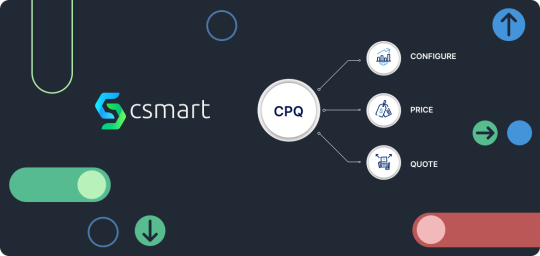#CPQ Implementation
Explore tagged Tumblr posts
Text
Maximizing Efficiency: A Deep Dive into CPQ Implementation
"In today's dynamic market, efficiency isn't just a goal; it's a necessity. CPQ implementation paves the way for streamlined processes and enhanced productivity, ensuring businesses stay ahead in the race."
Now, let's first see what CPQ implementation entails:
CPQ, or Configure Price Quote, is a strategic approach to sales automation that empowers businesses to accurately generate quotes, configure complex products, and automate pricing processes. It integrates seamlessly with existing CRM and ERP systems, ensuring a seamless flow of data across the sales pipeline. Essentially, CPQ simplifies the complex process of quoting and selling, enabling businesses to deliver precise quotes faster and with fewer errors.
Now, getting the idea about CPQ implementation, you might be wondering:
How long does CPQ implementation take?
CPQ implementation duration varies depending on factors such as company size, complexity of products, and existing infrastructure. On average, it can take anywhere from a few weeks to several months. However, with proper planning, robust training programs, and effective change management strategies, businesses can expedite the process and start reaping the benefits sooner. It's not just about installing software; it's about aligning technology with business objectives and ensuring seamless adoption across the organization.
Wait, wait, wait. But why are we here to read about CPQ implementation? It must have some noteworthy advantages.
Let's delve into the benefits of implementing CPQ:
The benefits of CPQ implementation are multifaceted and impactful. Firstly, it accelerates the quote-to-cash process by eliminating manual errors and reducing quote turnaround time. By automating repetitive tasks and guiding sales reps through the configuration and pricing process, CPQ ensures accuracy and efficiency at every step. Secondly, it enhances sales effectiveness by providing sales teams with intuitive tools for product configuration and pricing optimization. With CPQ, sales reps can quickly identify upsell and cross-sell opportunities, tailor quotes to meet customer needs, and ultimately close deals faster. Thirdly, it improves customer experience by ensuring accurate quotes and personalized offerings. By leveraging CPQ's capabilities for guided selling and quoting, businesses can deliver a superior customer experience, leading to higher satisfaction and loyalty. Moreover, CPQ empowers businesses with valuable insights through analytics, enabling informed decision-making and strategic pricing strategies. By analyzing quote data, sales performance metrics, and customer trends, businesses can optimize pricing strategies, identify market trends, and stay competitive in today's fast-paced market.
In conclusion, CPQ implementation is not just a technological upgrade; it's a catalyst for business growth and efficiency. By embracing CPQ, businesses can streamline their sales processes, drive revenue growth, and stay ahead in today's competitive landscape. It's not just about selling; it's about selling smarter and exceeding customer expectations at every touchpoint. CPQ isn't just a solution; it's a strategic investment in the future success of your business.
0 notes
Text
Salesforce CPQ: How to Use it for a Sustainable Future
In today's rapidly evolving business landscape, companies are not only expected to deliver top-notch products and services but also to do so in a sustainable and responsible manner. Sustainability is no longer just a buzzword; it's a driving force for positive change. Salesforce CPQ (Configure, Price, Quote) is a powerful tool that can help businesses not only streamline their sales processes but also contribute to a sustainable future.
Understanding Salesforce CPQ
Salesforce CPQ is a Salesforce-native solution designed to help businesses automate and optimize their configure, price, and quote processes. It enables sales teams to generate accurate and professional quotes, improve pricing strategies, and simplify the sales cycle. However, Salesforce CPQ's impact goes beyond just sales efficiency. It can be a game-changer in promoting sustainability within an organization.
The Intersection of CPQ and Sustainability
Reducing Environmental Impact: The traditional manual quote generation process involves printing documents, using resources, and contributing to a company's carbon footprint. Salesforce CPQ eliminates the need for physical documents by generating digital quotes and contracts. This not only reduces paper waste but also minimizes transportation-related emissions since everything can be shared electronically.
Energy Efficiency: By streamlining the quoting process, Salesforce CPQ can help your sales team work more efficiently, saving both time and energy. With automated workflows, you can reduce the number of clicks, tasks, and manual processes, resulting in significant time and energy savings.
Optimizing Resource Utilization: Salesforce CPQ allows businesses to better manage their product configurations, pricing, and quoting, reducing the risk of overproduction or wastage. This optimization can help companies minimize their environmental impact by producing and selling only what is needed.
Remote Work and Reduced Commuting: Salesforce CPQ supports remote work, reducing the need for employees to commute to the office. This shift towards telecommuting has the potential to decrease traffic congestion, lower fuel consumption, and decrease greenhouse gas emissions.
Empowering Sustainable Business Decisions
Salesforce CPQ not only aids in sustainable practices but also provides valuable insights that can inform environmentally responsible decisions. Here's how:
Data Analytics: CPQ generates valuable data related to sales, quotes, and product configurations. This data can be leveraged to make informed decisions about product lines and pricing strategies that align with sustainability goals.
Real-time Collaboration: The platform enables real-time collaboration between sales teams, distributors, and customers. This reduces the need for in-person meetings and travel, contributing to reduced carbon emissions.
Automated Approval Processes: With Salesforce CPQ, businesses can set up automated approval processes, which ensure that pricing and discounts align with sustainability guidelines and corporate social responsibility (CSR) policies.
The Path Forward
Incorporating Salesforce CPQ into your business's operations is a clear step towards a more sustainable future. It optimizes processes, reduces waste, and provides data-driven insights for informed decisions. By embracing this technology, you're not only improving the efficiency of your sales processes but also actively contributing to a greener and more sustainable planet.
As businesses continue to evolve and prioritize sustainability, Salesforce CPQ is a tool that can help organizations thrive in an environmentally conscious world. It's time to bridge the gap between sales and sustainability and make a positive impact on our planet's future.
Embrace Salesforce CPQ, and together, let's create a more sustainable and prosperous future for all.
#Salesforce CPQ#CPQ Software#Salesforce CRM#Sustainability Solutions#Sustainable Business Practices#Configure Price Quote#Sustainable Sales Strategies#CPQ Implementation#CPQ for Sustainability#Eco-Conscious Sales Processes
0 notes
Text
Salesforce Implementation Partners: Missing Link in the Picture?

Salesforce is a powerful platform with amazing features and endless capabilities. Businesses, regardless of the industry verticals, look forward to implementing Salesforce to strengthen their relationship with customers. Though it might sound simple and easy, starting an implementation without diligent preparation and planning often results in poor outcomes, which can require time-consuming and costly rework—this is where Salesforce implementation partners come to your rescue.
This blog answers some of the most common questions that people often have about working with a Salesforce implementation partner. In addition, it also tells you how to make the most of this strategic collaboration.
In response to changes in customer behaviors, businesses of varying sizes and scopes are accelerating their digital transformation initiatives. A majority of them are interested in employing integrated, access-from-anywhere kind of solutions such as a Customer Relationship Management (CRM) software/platform— just like the ones offered by Salesforce.
Here is what the statistics have to say about one of the fastest-growing categories of enterprise software: the global spending on Salesforce is projected to be around 675 billion U.S. dollars in the current year. In the previous year, Salesforce took approximately 24% market share of the global CRM applications market.

Going forward, exploring a Salesforce CRM solution is one aspect; knowing what applications, products, as well as configurations best suit your business-specific needs is totally another matter. Perhaps, this is why a majority of Salesforce customers resort to accredited experts to ease their entry into the world of Salesforce. These dedicated experts are your implementation partners. There is a wide network of Salesforce implementation partners that assist businesses to achieve their CRM goals quickly and effectively.
What is an Implementation Partner?
To put it in simple words, an implementation partner is a company that has been approved by Salesforce after reviewing it to implement Salesforce CRM solutions on its behalf where each implementation partner specializes in some specific areas, applications, or industries. This implies that there is a partner that caters to every business need, challenge, product, industry vertical, region, etc., and assists us along the entire Salesforce journey.
Why do Businesses Need an Implementation Partner?
Salesforce CRM solutions are known to cover the entire spectrum of business operations, which include marketing, sales, service, as well as sustainability. Each of its products can be bolstered via platform-to-platform integrations and add-on applications.
In other words, the entire Salesforce ecosystem offers endless capabilities—where the main challenge is to select the right product with the integrations and configurations that best fit your business-specific needs. Consider the case in point, a big organization might already be working with multiple technological solutions. They want to figure out how a Salesforce product, for example, Marketing Cloud, can be integrated with their existing workflows without causing friction, and are looking for assistance for the same.
Take another case in point, a smaller company might be scaling upwards quickly. They also know that continuing to work with spreadsheets would not support their growth. Amidst this, they realize that they must automate their processes—or it is time to develop more streamlined and personalized customer experiences.
Implementing a CRM solution for the first time can be daunting for a majority of companies. It is a challenging task for internal teams or employees with no experience in Salesforce to take into consideration all the variables as well as implement a new and highly configurable CRM solution. Besides, hiring a full-time employee to look after the CRM implementation process can also be a costly avenue.
These were some of the situation-specific reasons that a significant chunk of Salesforce customers resort to partner applications and experts.
When is the Right Time to Engage with Implementation Companies?
As early as possible would be apt if it were to be answered in a nutshell.
You need to do your due diligence, just like you do with any significant investment. First of all, figure out what needs have to be met, gaps that have to be closed, or issues that need to be addressed. Talking of the Salesforce implementation case, you must formulate a vision of what you want to achieve that is the ‘what.’ After this, determine the ‘how,’ which is often the most complicated part for any business.
It is time to bring in a partner as soon as you figure out your goals. The right implementation partner will not just facilitate the ‘how,’ but they’ll also help you crystallize the ‘what’. They will assist you to clarify your success metrics, understanding what is realistic, as well as advise on appropriate products. Accordingly, the experts will lay out a logistically sound timeline for your implementation journey to finish it off.
It is important to note that bringing in a partner late in the game usually results in missed opportunities—in terms of understanding and scope. As the relationship between a partner and a customer is close and collaborative, the only secured way to ensure seamless implementation is when the journey begins together.
How to Figure Out the Right Implementation Partner?
Some of the implementation partners have generalized Salesforce capabilities. More often than not, these companies specialize in particular functions or areas of the CRM solution. While some might specialize in customer data platforms (CDP) or Marketing Cloud, others might specialize in harnessing the combined powers of Einstein and Sales Cloud.
Another factor is value alignment, which has come to the forefront in recent years. People want to work with companies that share their values. What we mean here is that people prefer to work with an organization that prioritizes sustainability or champions diversity and equality.
Shopping around is a good practice irrespective of whether or not these things are top-of-mind for you. Interact with different Salesforce partners, get a feel of who they are, know the way they work, and so on. As this is an important relationship, we would recommend you not settle for anything less than the right fit for your business.
Salesforce AppExchange is the best as well as a most comprehensive resource for both partners and products. There are plenty of experts and numerous applications at your fingertips where one can also browse specializations, certifications, and customer reviews.
In short, certifications, as well as credentials come into play as does the specific expertise of that implementation company.
What Challenges Might a Business Encounter During Implementation?
It has already been stressed enough that bringing in a partner as early as possible decreases the chances of challenges that might be emerging down the line.
What is also important apart from this is to be clear on what you want to solve, plus how you measure success over time. Most instances of dissatisfaction or confusion emerge from a lack of understanding on the part of the partner or the customer. Fault assumptions can be made and misunderstandings on capabilities and timelines can arise if both the parties, partner and customer are not on the same page. This makes goals, objectives, and success benchmarks harder to be reached.
As a customer, you need to be as transparent as you want your Salesforce implementation partner to be. Genuine advice is that you should never be afraid to ask questions more than once and it is better to clear all the doubts that you have got—the implementation process is highly technical in nature and seeking clarification in this is quite natural.
Just as stakeholders place the customer at the center of their business, Salesforce implementation partners place them at the center of theirs. Also, they measure their success by aligning the outcomes to your business-specific needs; in other words, by delivering exactly what you need. For dedicated Salesforce implementation companies customer success equals partner success.
Last but not the least, every successful relationship in life thrives on honest, open communication from the outset; and the Salesforce implementation partnership is no exception to this rule.
Final Thoughts
To achieve exceptional results and maximize license usage, it is important to ensure that your Salesforce solution is fully tuned to business-specific needs and well-adopted by your organization. To maximize the success of Salesforce implementation, you need to engage with a Salesforce implementation partner.
You might be missing out on the potential opportunities in terms of scope and understanding, due to insufficient resources or skill gaps. Besides, the relationship between an implementation partner and a customer is collaborative and close. So, the only way to ensure a successful implementation is when the journey begins together.
The next step is to meet and network with different partners to get a feel of who they are, what is their way of working, and so on—this is an important relationship, so you must not settle for anything less than the best fit for your business. Now that you know what is right for you, it is time to make the move.
#salesforce implementation partners in india#salesforce implementation partners#salesforce implementation companies in india#salesforce implementation companies#salesforce implementation services#salesforce implementation consultant#salesforce implementation company#salesforce cloud implementation#salesforce cpq implementation partners
1 note
·
View note
Text
Trusted Salesforce Consulting Company for Global CRM Solutions – AwsQuality Looking for a trusted Salesforce Consulting Company to boost your CRM strategy? AwsQuality delivers expert Salesforce solutions tailored to your business needs across the USA, UK, Dubai, and beyond. 📩 Get in touch: [email protected]
Read more- https://www.awsquality.com/salesforce-integration-companies-vs-diy-whats-right-for-your-business/
#salesforcedevelopment#implementation#salesforce#salesforceconsultingcompany#salesforceintegration#crmsolution#freeaudit#cpq
0 notes
Text

Salesforce CPQ implementation helps businesses automate complex pricing, streamline quote generation, and improve sales efficiency. With seamless CRM integration, it ensures accurate quotes, faster approvals, and enhanced revenue growth. A well-executed implementation optimizes pricing strategies, accelerates deal closures, and enhances sales forecasting. Implement Salesforce CPQ implementation today to drive efficiency and maximize ROI.
0 notes
Text

Calculate the ROI of Salesforce CPQ
Salesforce is truly a force; businesses worldwide have experienced a meteoric rise in their outcomes and processes. Calculate the ROI of your Salesforce project now: https://shorturl.at/7BzJR
Explore our Salesforce Professional Services: https://shorturl.at/5FdRd
#Salesforce CPQ#Salesforce CPQ ROI#Salesforce CPQ Cost Calculator#Salesforce Implementation ROI#Salesforce Revenue Cloud ROI#Salesforce Cloud ROI
1 note
·
View note
Text
#salesforce#cpq best practices#salesforce cpq best practices#salesforce cpq implementation partners#salesforce cpq#cpq#salesforce cpq implementation guide#salesforce cpq implementation guide pdf
1 note
·
View note
Text

#salesforce cpq software#salesforce cpq solution#salesforce cpq tool#salesforce cpq implementation services#cpq services#cpq solutions#salesforce cpq solutions
0 notes
Text
Salesforce Experience Cloud: Empowering Businesses with Exceptional Digital Experiences

Salesforce Experience Cloud is a powerful platform that empowers businesses to create exceptional digital experiences. Leveraging its customization, personalization, collaboration, and self-service capabilities, companies can enhance engagement, drive customer satisfaction, and foster long-lasting relationships with their customers, partners, and employees. Experience Cloud is a valuable tool for organizations aiming to differentiate themselves and succeed in today’s digital-first business landscape.
Key Features of Salesforce Experience Cloud:
All You Need to Know About Salesforce Experience Cloud
1. Customizable User Interface:
– Tailor personalized user interfaces to your brand and user preferences.
– Customize the look and feel of your community sites or portals.
2. Community Builder:
– Create engaging and interactive experiences for customers, partners, and employees using a user-friendly drag-and-drop interface.
– Effortlessly build community sites, portals, and forums.
3. Mobile-Optimized Experiences:
– Ensure a seamless and responsive experience across various mobile devices.
– Allow users to access your community on smartphones and tablets.
4. Content Management:
– Manage various types of content, including articles, documents, and videos.
– Provide valuable information and resources to your community members.
5. Collaboration Tools:
– Foster communication and collaboration among community members.
– Utilize discussion boards, chat functionality, and social collaboration tools for enhanced interaction.
6. Personalization and Recommendations:
– Deliver personalized experiences based on user preferences and behavior.
– Enhance user engagement with relevant content, products, and services recommendations.
7. Case Management:
– Enable users to create and track support cases within the community environment.
– Efficiently resolve issues and provide customer service.
8. Integration Capabilities:
– Seamlessly integrate with other Salesforce products and third-party systems.
– Leverage existing data and workflows for a connected experience.
– Ensure data security and control user access to information and functionality.
Using Salesforce Experience Cloud Offers Benefits for Businesses:
Enhanced Customer Engagement: Experience Cloud enables businesses to create engaging and personalized experiences for their customers, leading to higher engagement and satisfaction levels.
Improved Collaboration and Communication: By facilitating collaboration among customers, partners, and employees, Experience Cloud enhances communication, knowledge sharing, and teamwork within the digital community.
Cost Savings: The self-service capabilities of Experience Cloud reduce the workload on support teams and enable customers to find answers independently, resulting in cost savings and increased operational efficiency.
Brand Consistency: Experience Cloud allows businesses to customize the user interface, branding, and design elements, ensuring a consistent brand experience across all touchpoints and reinforcing brand identity and recognition.
Scalability and Flexibility: Experience Cloud is highly scalable and adaptable to the evolving needs of businesses. It supports customization and provides a flexible framework for creating tailored digital experiences.
Use Cases and Success Stories:
I. Real-world Examples of Businesses Leveraging Experience Cloud:
Hewlett Packard Enterprise (HPE): HPE used Experience Cloud to create a personalized partner portal, resulting in a 23% increase in partner engagement and a 6% increase in revenue per partner.
AmerisourceBergen: AmerisourceBergen utilized Experience Cloud to create a self-service portal for pharmaceutical customers, leading to a 20% increase in customer satisfaction and a 40% reduction in customer service calls.
II. Specific Use Cases Across Various Industries:
Healthcare: A healthcare provider can leverage Experience Cloud to create a patient portal, improving patient satisfaction and engagement while streamlining appointment scheduling processes.
Financial Services: A financial services company can utilize Experience Cloud to create a personalized client portal, leading to increased client retention and satisfaction, as well as streamlined communication and account management processes.
Manufacturing: A manufacturing company can use Experience Cloud to create a partner portal, resulting in improved partner engagement, increased sales, and streamlined partner management processes.
The Future of Experience Cloud:
The future of Experience Cloud involves mobile-first experiences, voice-enabled capabilities, IOT integration, and AR/VR technologies. AI and machine learning will play a pivotal role in enhancing personalization, providing intelligent recommendations, enabling automation, and delivering data-driven insights. As businesses leverage these advancements, they must navigate the ethical considerations associated with AI to ensure the responsible and beneficial use of technology in creating exceptional user experiences.
In conclusion, Salesforce Experience Cloud empowers businesses to create engaging digital experiences, foster collaboration, and provide self-service capabilities. Its customization options, integration capabilities, and future advancements make it a valuable tool for delivering exceptional customer and partner experiences. We encourage readers to explore Experience Cloud and leverage its capabilities to drive customer satisfaction, engagement, and business growth. Remember, the digital landscape is evolving rapidly, and Experience Cloud can help businesses stay ahead by delivering personalized, seamless, and impactful experiences that drive success in today’s competitive business environment.
Author: Prashant Patil
Tags: salesforce data migration services, salesforce data migration services, salesforce data migration services, salesforce data migration services, salesforce data migration services
Read More At: https://leanitcorp.com/salesforce-experience-cloud-empowering-businesses-with-exceptional-digital-experiences/
#best salesforce consulting firms#salesforce cpq consulting#top salesforce consulting firms#salesforce customization partners#salesforce nonprofit consultants#salesforce implementation partners#salesforce managed services partner#salesforce nonprofit partners#salesforce data migration services
0 notes
Text
Streamlining Sales Processes: A Guide to CPQ Implementation

Introduction: Getting Around in the Complicated World of Telecom Service providers in the quick-paced telecommunications industry struggle to keep track of a wide range of plans, rates, and services. Intricate product configurations and competitive pricing make this challenge even more difficult, and internal approval procedures can impede customer service and erode brand loyalty.
0 notes
Text
Step-by-Step Salesforce CPQ Implementation Guide
In today's rapidly evolving business landscape, optimizing sales processes is imperative for success. Salesforce CPQ (Configure, Price, Quote) emerges as a powerful tool to streamline and enhance the sales cycle. This step-by-step implementation guide serves as your compass through the intricacies of integrating Salesforce CPQ, ensuring a smooth transition and maximizing its potential.
Understanding the Basics
Before diving into the implementation process, it's crucial to comprehend the fundamentals of Salesforce CPQ. This cloud-based solution empowers businesses to automate and customize the quoting process, minimizing errors and accelerating sales.
Step 1: Assess Your Business Needs
Begin the implementation journey by conducting a thorough assessment of your business requirements. Identify specific pain points in your current sales processes and outline objectives you aim to achieve with Salesforce CPQ. This foundational step sets the stage for a tailored and effective implementation.
Step 2: Plan and Design
Craft a detailed implementation plan and design that aligns with your business goals. Define product configurations, pricing rules, and quoting workflows. Collaborate with key stakeholders to ensure that the designed system meets the unique needs of your organization.
Step 3: Data Migration
Efficient data migration is paramount to a successful CPQ implementation. Migrate existing product, pricing, and customer data seamlessly into Salesforce CPQ. Conduct thorough testing to validate data accuracy and integrity.
Step 4: Configuration
Leverage the flexibility of Salesforce CPQ to configure products and pricing based on your business rules. Customize quote templates, discount structures, and approval processes to match your unique requirements. This step ensures that the system is finely tuned to your business nuances.
Step 5: Integration with Salesforce CRM
Integrate Salesforce CPQ seamlessly with your existing Salesforce CRM for a unified platform. This integration enhances collaboration between sales and other departments, providing a holistic view of customer interactions.
Step 6: User Training
Empower your team with comprehensive training on the newly implemented Salesforce CPQ system. Ensure that users are proficient in utilizing the platform to its full potential, maximizing productivity and minimizing errors.
Step 7: Testing and Optimization
Before full deployment, conduct rigorous testing to identify and address any issues. Optimize configurations based on user feedback and real-world usage, refining the system for peak performance.
Step 8: Deployment and Continuous Improvement
Roll out the Salesforce CPQ system across your organization in a phased manner. Monitor its performance and gather feedback for continuous improvement. Regularly assess and update configurations to adapt to evolving business needs.
By following this step-by-step Salesforce CPQ implementation guide, businesses can unlock the full potential of this powerful tool, enhancing sales processes and driving revenue growth. Embrace the future of sales efficiency with confidence and precision.
1 note
·
View note
Text
Elevating Connected Customer Experiences with the launch of Salesforce Integration Cloud

Create wildly desirable customer experiences through Salesforce Integration Cloud – the revolutionary Data Integration solution launched by Salesforce.
One of the most persistent problems that the IT realm faces is issues pertaining to connecting systems to disparate data sources. Integrations like this across a company bring with it enormous challenges for both the business users and the SaaS/Cloud service providers. Research indicates that 54% of businesses have missed project deadlines in the last 6 months due to Cloud Integration problems. Also, one in two businesses has entirely abandoned a Cloud app in the last 3 years primarily due to the integration hassles. Moreover, more than half of all Cloud adopters have tried and failed at Cloud Integration altogether.
To combat this complex and rising Data integration issue, Salesforce has made yet another smart decision by introducing its own Integration Cloud. Salesforce Integration Cloud harnesses the latest advancements in technology to deliver connected customer experiences through next-gen Data Integration solutions. It combines a unique set of tools and services to connect every system, customer and device to surface data regardless of where it resides – this ensures connected Customer Experience (CX) across all channels. The Salesforce Integration Cloud has three layers that contribute significantly in different ways to the Data quality, accuracy and efficiency.
Integration Platform is a comprehensive solution for all of Data Integration needs. It combines the critical capabilities of a complete Data Integration, Data Quality, and Data Governance solution into a single unified Cloud-based platform to slickly and efficiently integrate services, devices, data, systems, processes and business partners across any cloud. Its extensive Data governance capabilities allow customers to meet their unique set of business needs in one single platform to collaborate across projects seamlessly.
Integration Builder is a feature that can be used to build a single 360-degree view of the customer across all the Salesforce deployments as well as the entire network of business systems – simply with clicks and not code. Developers can manage these connections through a single console that encapsulates an array of features to search, edit & manage objects, make personalized settings, define work areas to group objects as well as other specialized tasks.
Integration Experiences – Developers can bring together Salesforce customer data in unique and innovative ways to create frictionless CX across clouds including sales, service, marketing, commerce and more. For instance, a developer can use the Lightning App builder to integrate the commerce order history data into the Lightning service console to transform service interactions into upselling and cross-sell opportunities – accomplishing all of this without ever leaving the comfort of their console.
DemandBlue has partnered with leading players from SMBs to Fortune 100s to transform customer experiences through cutting-edge Salesforce solutions. Now, with the addition of Salesforce’s newest launch – the Integration Cloud, it’s time that you take advantage of our Salesforce Integration Cloud services powered by On Demand Service model to deliver Speed, Value, and Success to your enterprise. To accelerate your Digital Transformation through Data Integration.
This blog published by another site and the blog url is : https://demandblue.com/salesforce-consulting-services/
salesforce salesforce integration salesforce consulting salesforce services salesforce solutions
0 notes
Text
Streamlining Quote-to-Cash: Best Practices for Salesforce CPQ Implementation
Efficient Salesforce CPQ Implementation is crucial for optimizing quote-to-cash processes. This article discusses best practices that ensure seamless integration and enhanced productivity. Key strategies include thorough requirement analysis, user training, and regular feedback loops. By focusing on these aspects, businesses can reduce errors and improve customer satisfaction. Implementing these practices not only streamlines operations but also enables teams to respond swiftly to market changes, ultimately driving growth and revenue. Explore these insights for a successful implementation journey.
#SalesforceCPQ #SalesforceConsulting #QuoteToCash #CPQImplementation #SalesOptimization #SalesforceExperts #DigitalTransformation #SalesforcePartners #SalesEnablement #CRM
0 notes
Text
SAP CPQ Solution
Discover the power of SAP CPQ. Elevate your sales operations with SAP CPQ solutions, expert consulting services, and tailored solutions.
SAP CPQ Solution
https://mobolutions.com/sap-configure-price-quote/
0 notes
Text
Best Practices for Salesforce CPQ Implementation
Generating quotes is a complex task that requires thorough analysis of client requirements and efficient resource planning. Salesforce CPQ automates this process with precision, ensuring efficient sales operations.
Our recent blog explores the importance of Salesforce CPQ, it's industry applications, and tips for successful implementation.
Read now:
0 notes
Text

Salesforce CPQ Implementation Partners
AwsQuality serves as a distinguished Salesforce CPQ implementation partner. Their certified experts specialize in configuring and optimizing Salesforce CPQ solutions, streamlining pricing and quoting processes. With their expertise, businesses achieve greater efficiency, accuracy, and customer satisfaction in their sales operations.
Read more: https://www.awsquality.com/services/salesforce-implementation/
0 notes